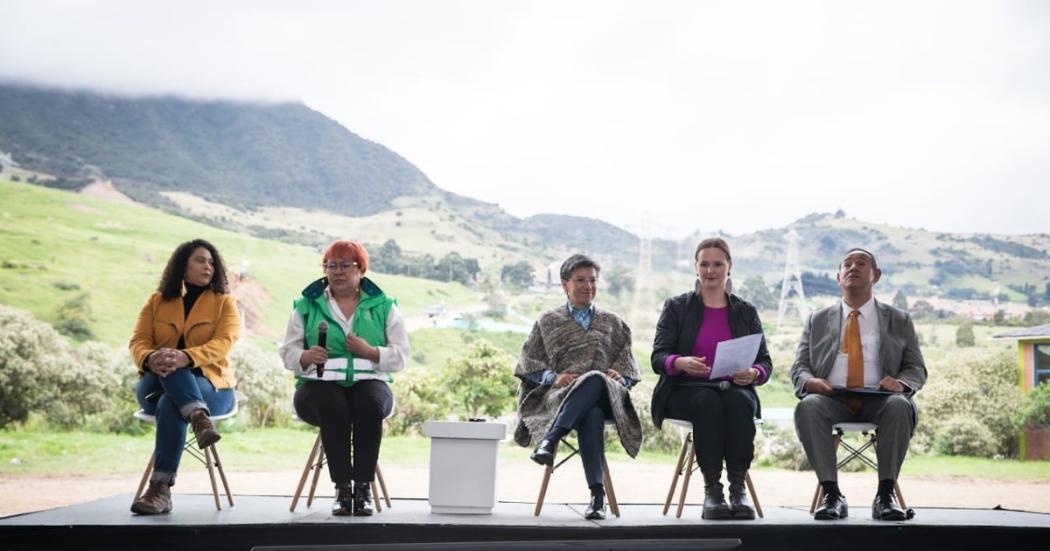Bogotá will become the first city in Colombia and the second in Latin America with a Waste-to-Energy Plant —a model that is also being implemented in parallel in Mexico City— in which inorganic waste is decomposed through heat. This process is beneficial for the environment, since it generates low CO2 emissions and makes waste management efficient by converting waste into energy.
“For those who believed that our Climate Action Plan and the POT were just regulations, today we show you another result. We are on the Doña Juana public where we now have two technologies at work; the first is the Biogas plant, the second is the burying of garbage. The latter is harmful as it produces leachates, methane, and greenhouse gases,” said the Mayor, Claudia López.
Bogotá’s representative added: “Today we are announcing to the city that we will now have a third technology to treat waste that will reduce the environmental impact and generate energy for the city. With this new plant we are fulfilling our promise to residents of Ciudad Bolívar, Usme, and Tunjuelito, who asked us to stop taking waste to their boroughs to bury it there. We are not going to continue to expand Doña Juana.”
Contenidos relacionados
Here, a tweet in which Mayor López, recalls that with this Waste-to-Energy Plant she fulfills a promise she made to Bogotá:
Transformar Doña Juana en un parque de innovación tecnológica con energías limpias, que brinde beneficios para la comunidad del sur de la ciudad, fue mi compromiso como candidata, hoy es mi promesa cumplida como Alcaldesa y parte de #LaBogotáQueEstamosConstruyendo! pic.twitter.com/CQ5iR22WvW
— Claudia López Hernández (@ClaudiaLopez) May 11, 2022
The process begins today with the publication of the contract pre-specifications, which will be available on the SECOP II public procurement platform for 20 business days. Subsequently, the final bid specifications will be published and the public tender will be held, to be awarded in September of this year.
“This is an achievement that passed through the government program, through the Development Plan, and through the POT. Now, it is a reality. This model has already been implemented in other parts of the world and now we’re doing it here, in Bogotá. Now we can proudly tell our people that we are treating waste differently,” said Luz Amanda Camacho, director of the Special Administrative Unit of Public Services (UAESP, as the acronym in Spanish).
In this tweet, Mayor Claudia López, shares that as of May 11, the tender to build this technological innovation park will open:
Bienvenidos a otra meta cumplida del POT y del Plan de Acción Climática de Bogotá! Hoy abrimos licitación internacional para tener una nueva tecnología de procesamiento de residuos en Doña Juana: la termovalorización, que transforma residuos en energía limpia. pic.twitter.com/WEl1stlRc3
— Claudia López Hernández (@ClaudiaLopez) May 11, 2022
The plant, which will be built in the Doña Juana Innovation Park, will be implemented in modules. The first module will come into operation in December of next year, and by 2027, it will transform between 2400 and 3000 tons of waste every day, generating more than 128 megawatts of energy, enough to power all public lighting in Bogotá or more than 40,000 homes in the city.
Additionally, the ashes resulting from the combustion of waste will be sold as construction materials. In this way, the use of one hundred percent of the treated material is guaranteed, as is the reduction of the generation of leachates that affect the subsoil and the Tunjuelito River.
In addition, thanks to the emissions cleaning system, the Waste-to-Energy Plant together with Biogas Colombia will reduce the emissions of polluting gases to the ozone layer by 66 percent, compared to what is produced today with the burying of waste.
This plant will become a benchmark for other cities in Colombia and the region, by contributing to changing the current model of waste treatment and promoting the circular economy in Bogotá, contributing to the fight against climate change.
“The management of public waste with this plant will reduce the production of methane and greenhouse gases, in addition to lowering emissions and their impact. The leachates that contaminate the Tunjuelo river basin will also be reduced,” confirmed the Secretary of Environment, Carolina Urrutia.
The financial model proposed by the UAESP for this process includes the sale of both the energy generated and the ashes resulting from the plant’s operations, with the aim of obtaining the necessary income for its continued correct functioning, avoiding an increase in cleaning fees paid by citizens.
“Today we buried 6200 tons of waste in Bogotá, now with the Biogas plant and the Waste-to-Energy plant, this waste will be transformed into energy. This model will contribute to the circular economy and will not affect the rate that we currently pay for cleaning,” added the director of the UAESP.
This important project is added to the portfolio of waste management initiatives carried out by Bogotá’s Recycling Organizations, as well as the organic waste treatment pilot projects, and of special note, the reduction of 7000 tons per month of demolition and construction waste, the result of illegal dumping at so-called critical points.
District receives resources for Gas generated in Doña Juana
During the event, the Mayor of Bogotá, Claudia López, and the director of the UAESP, Luz Amanda Camacho, toured the Biogás Colombia plant and verified the process that is carried out to convert the gases generated by buried waste into electrical energy.
At the end of the tour, the manager of Biogás Colombia, Helmuth Gallego, presented the Mayor with a check for 2.475 billion pesos, product of the profits generated from the sale of energy during the first half of 2021. This money will be invested entirely in actions to improve the quality of life of the inhabitants in Doña Juana’s area of influence.




